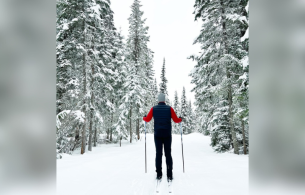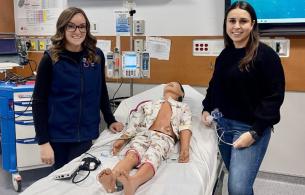This story was co-written by Paula Tait and Randi Parsons.
Northerners are learning to live with wildfire smoke. Each year, spring and summer bring lingering smoke for weeks (and sometimes months) in many communities. It’s important that we plan year-round to protect our communities, even before the smoke rolls in.
Pregnant people and families with infants and young children need extra protection. Wildfire smoke can take a toll on their physical, emotional, mental, and spiritual health. Community partners play an important role in keeping them safe and resilient during smoky times.
Let’s explore some ways communities can boost supports for young families. Municipalities, Indigenous partners, community-based programs, and folks who care for this population may find this information helpful.
Wildfire smoke affects our health
It's one of the biggest sources of air pollution we’re exposed to. So, it's important we understand its health impacts. Wildfire smoke is a complex mixture of tiny particles and harmful gases. Its quality changes quickly, depending on the fuels in the fire, the weather, and the distance from the fire. Learn more about wildfire smoke from the BCCDC.
Breathing in smoky air affects our lungs, even when we wear a medical mask or cloth mask. Those tiny particles travel deep into our lungs and put stress on our whole body. When this happens to pregnant people and young children, the impacts can be serious: research shows a link between wildfire smoke and poor health outcomes. For young families, that can look like:
- More visits to the hospital
- Diabetes in pregnancy
- Babies with low birth weight
- Young children with impaired lungs
So, how do communities protect young families? The best strategy is to be prepared each year. Help young families to:

- Stay informed about smoky conditions and supports available
- Keep indoor environments safe with clean indoor air
- Find clean air spaces throughout the community
- Lean on the community for additional support if needed
Read on to learn more about each of these steps.
Share information about smoky conditions and available supports
Community partners can make quality information available to young families in different ways. Some options to consider:
- Displaying information from trusted sources at local gathering places, like public libraries and community centres. This could include printed BCCDC fact sheets about wildfire smoke.
- Sharing regular social media posts from trusted sources like the BC air quality subscription service, the BC wildfire service, and the BCCDC.
- Hosting local town hall meetings to allow families to ask questions and address their concerns.
- Offering free local workshops to teach families how to make their own do-it-yourself (DIY) air cleaners.
Keep indoor spaces safe with clean air
We spend most of our time indoors, so clean indoor air is good for our health. Encourage young families to breathe clean air by:
- Keeping windows and doors closed (if it's not too hot outside).
- Using an indoor air cleaner with HEPA filtration to filter the tiny particles out of the air. It's okay to just focus on one or two rooms in the indoor space.
- Building DIY indoor air cleaners. Follow these tips: Home-made box air fan filters.
- Minimizing other sources of indoor air pollution. Keep the dust down, vent cooking and chemical fumes, and avoid air fresheners or other scented products.
Find clean air spaces throughout the community
Communities can provide cool, clean air and temporary refuge for young families who are not able to shelter in place at home. These spaces could be community halls, public libraries, shopping centres, and recreational facilities. Benefits:
- Provide opportunities to get active and/or play in a clean-air space.
- Provide social connection and peer support.
- Support the mental wellness of the entire family.
Consider reaching out to a heating, ventilation, and air conditioning (HVAC) professional who can advise on how to increase indoor air quality in these spaces.
Lean on the community for additional support

During smoky times, there are other ways community partners can support young families. These could include:
- Helping them take advantage of clean-air days by hosting community events (either indoors, or outdoors in greenspace, when it's safe to do so). Examples can include library programs, community celebrations, and playful group activities.
- Helping them find out where to learn about limiting time outdoors or when to limit or adjust exercise outdoors, since this causes us to breathe more air into our lungs.
- Making masks available, because they remove more than 90% of smoke particles. It's important families understand how and when masks can be used. Small adult masks can be used for children who are over two years of age as long as they can communicate about how they're breathing with the mask on. Learn more about face masks for wildfire smoke.
Start planning now for wildfire smoke
Community support helps to keep young families protected and resilient each year. Here are some resources to help you get started:
- BC state of the air report – BC Lung Foundation
- How to breathe easier during wildfire season when pregnant – BC Women's Hospital & Health Centre
- Tips for wildfire smoke and children – BC Children's Hospital
- Wildfire smoke and clean air shelters (PDF) – First Nations Health Authority (FNHA)














Comments